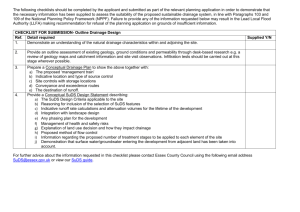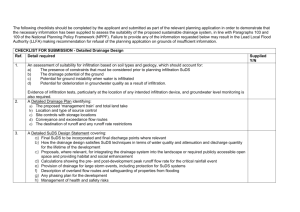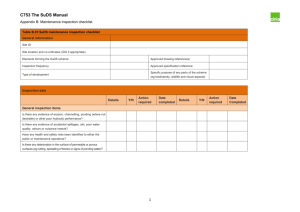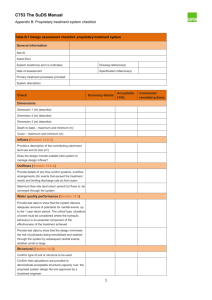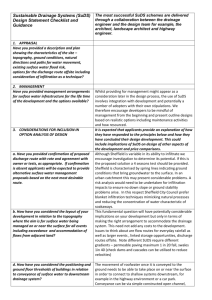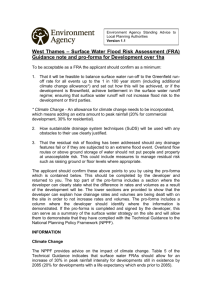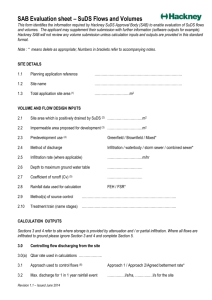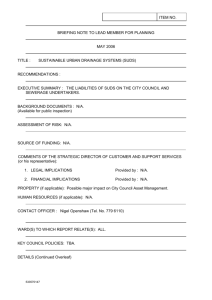Scheme design assessment
advertisement
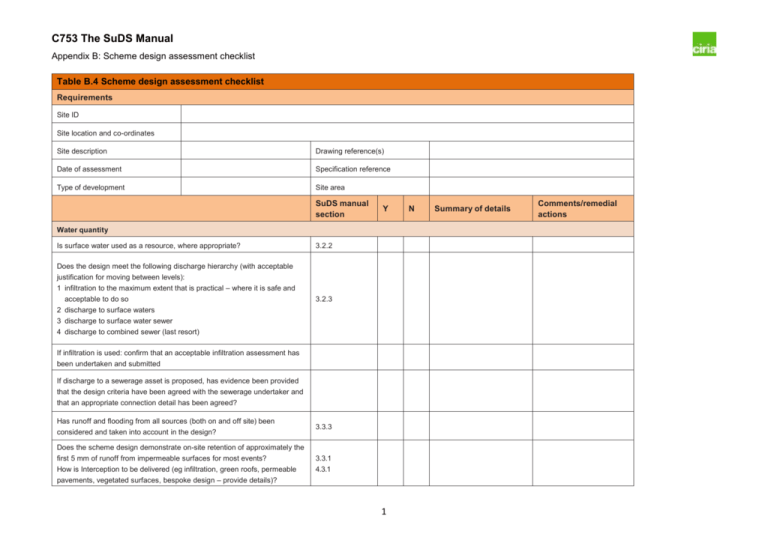
C753 The SuDS Manual Appendix B: Scheme design assessment checklist Table B.4 Scheme design assessment checklist Requirements Site ID Site location and co-ordinates Site description Drawing reference(s) Date of assessment Specification reference Type of development Site area SuDS manual section Y Water quantity Is surface water used as a resource, where appropriate? 3.2.2 Does the design meet the following discharge hierarchy (with acceptable justification for moving between levels): 1 infiltration to the maximum extent that is practical – where it is safe and acceptable to do so 2 discharge to surface waters 3 discharge to surface water sewer 4 discharge to combined sewer (last resort) 3.2.3 If infiltration is used: confirm that an acceptable infiltration assessment has been undertaken and submitted If discharge to a sewerage asset is proposed, has evidence been provided that the design criteria have been agreed with the sewerage undertaker and that an appropriate connection detail has been agreed? Has runoff and flooding from all sources (both on and off site) been considered and taken into account in the design? 3.3.3 Does the scheme design demonstrate on-site retention of approximately the first 5 mm of runoff from impermeable surfaces for most events? How is Interception to be delivered (eg infiltration, green roofs, permeable pavements, vegetated surfaces, bespoke design – provide details)? 3.3.1 4.3.1 1 N Summary of details Comments/remedial actions C753 The SuDS Manual Appendix B: Scheme design assessment checklist Requirements Does the design demonstrate adequate control of the 1 year, critical duration site event? 3.2.3 3.3.2 Does the design demonstrate adequate control of the 100 year, critical duration site event (including urban creep and climate change allowances)? 3.2.3 3.2.7 Does the design demonstrate adequate control of the 100 year, 6 hour runoff volume from the site? 3.2.3 3.3.1 Are any natural hydrological features on the site adequately protected by the design? 3.2.4 Are all SuDS components outside any areas of significant flood risk? If not, provide justification and evidence that the risks to system performance are acceptable 3.2.5 Is pumping a requirement for the operation of the system? If yes, have all other possible alternatives been considered appropriately? 3.2.5 Have infiltration rates, hydraulic gradients and any downstream constraints been evaluated to ensure that the components will drain down within a suitable timescale? 3.2.5 Are flows up to the agreed standard of service event (including allowances for 3.2.6 urban creep and climate change) fully conveyed within the drainage systems? 3.2.7 Are flows up to the agreed exceedance standard of service event (including allowances for urban creep and climate change) contained or stored on site within safe exceedance storage areas and flow paths? Are these areas and flow paths protected from future development? 3.2.6 3.2.7 3.3.3 Water quality Does the design include an appropriate treatment strategy to ensure that: ▪ sediment is trapped and retained on site in accessible and maintainable 4.2.2 areas? ▪ suitable SuDS components have been provided in series before 4.3.2 discharge that provide acceptable treatment, taking account of proposed site land use and the status of all receiving water bodies? Has consideration been given to the potential implications of climate change on the capability of the SuDS components to provide the required treatment? 4.2.3 2 C753 The SuDS Manual Appendix B: Scheme design assessment checklist Requirements Amenity criteria Where the drainage system serves more than one property, is public space used and integrated with the drainage system in an appropriate and beneficial way? 5.2.2 Does the proposed scheme enhance the visual character of the development? 5.2.3 Are the proposed components safe for any proposed amenity use? Has a health and safety risk assessment been undertaken? 5.2.4 Chapter 36 Checklist B.3 Have opportunities been taken to use the drainage system to enhance development resilience to future climate change scenarios? 5.2.5 Is the structure and function of the drainage system clear and obvious to the local community? 5.2.6 Do the design proposals include sufficient provision for community engagement and awareness raising? 5.2.7 Biodiversity criteria Will the drainage system support and protect natural local habitats and species? 6.2.1 Will the drainage system contribute to the delivery of local biodiversity objectives? 6.2.2 Does the design support local (and wider where possible) habitat connectivity? 6.2.3 Does the design promote the creation of diverse, self-sustaining and resilient ecosystems? 6.2.4 Constructability Has an acceptable construction method statement been submitted and approved? Chapter 31 3 C753 The SuDS Manual Appendix B: Scheme design assessment checklist Requirements Maintainability Are the design features sufficiently durable to ensure structural integrity over the system design life, with reasonable maintenance requirements? Chapter 32 Are the operating and maintenance requirements of the drainage system adequately defined? Chapter 32 Has an acceptable Maintenance Plan been submitted and approved? Chapter 32 Cost-effectiveness Is operation and maintenance achievable at an acceptable cost to the adopting body (including any pumping requirements)? Chapter 35 Safety Are the proposed components safe to construct, maintain and operate? Has a health and safety risk assessment been undertaken? System design acceptability Summary details including any changes required Chapter 36 Checklist B.3 Acceptable (Y/N) Date changes made Acceptable: Minor changes required: Major changes required/redesign: 4
